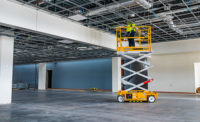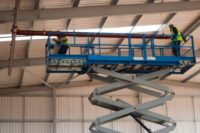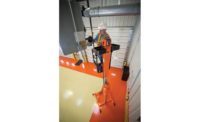Scissor lifts and aerial lifts have replaced ladders and scaffolding in many general industry workplaces due to their mobility and flexibility in allowing workers to perform certain job tasks. Using this equipment poses serious hazards which OSHA says can and does lead to worker injuries and death. in one year, the agency reports it found ten preventable fatalities and more than 20 preventable injuries resulting from a variety of incidents involving scissor lifts alone.
OSHA says that falls are among the most serious hazards associated with scissor and aerial lift use. Unfortunately, there are no general industry standards that specifically address this issue, but OSHA does provide guidance in various Letters of Interpretation (LOIs), publications, and the construction standards. Employers can elevate their understanding of scissor and aerial lift fall protection by thoroughly reviewing this information.
Scissor vs. aerial lifts
There are numerous types of “lifts” used in industry, and it can be confusing for employers. Per OSHA, a scissor lift is a mobile scaffold for which the platform only moves vertically. An aerial lift is any vehicle-mounted work platform that can move vertically and/or horizontally. Some aerial lifts can even rotate around a vertical axis.
Aerial lifts are used to lift workers to difficult work positions that aren’t able to be accessed by other equipment, even scissor lifts. This is also why aerial lifts are extremely hazardous. Lifting a worker up and out can make the lift extremely unstable if not operated correctly.
The use of both scissor and aerial lifts inherently presents fall hazards to workers. As such, understanding the basic difference between each helps ensure that you’re implementing the correct safety measures in your workplace. This is particularly critical regarding fall protection.
General fall protection
OSHA says that employers should ensure that workers adhere to the following general fall protection measures when utilizing scissor and aerial lifts:
- Ensure that guardrails conforming to the requirements of 1910.23(e) are present and in good repair.
- Close access gates or openings.
- Stand firmly on the floor of the bucket or work platform.
- Do not climb or lean over guardrails or handrails.
- Keep work within easy reach to avoid leaning away from the lift.
- Do not use planks, ladders, or other devices as a working position.
Personal fall protection
OSHA addresses the use of personal fall protection on scissor and aerials lifts in several LOIs. The protection is different for each lift. The reason for this is because the design and function of a scissor lift is different from that of an aerial lift, thus posing varying degrees of risk for falls.
Scissor lifts
In an August 2000 LOI, OSHA says that a scissor lift is a type of scaffold. In this letter, the agency states that if the scissor lift has guardrails that meet OSHA requirements, then this is all that is required for fall protection. In other words, workers do not have to be tied-off if the scissor lift has a properly designed and maintained guardrail system. The guardrails themselves serve as the necessary fall protection.
Aerial lifts
Fall protection for aerial lifts is different. OSHA’s general industry aerial lift standard at 1910.67(c)(2)(v) requires that a body belt be worn and a lanyard attached to the boom or basket at all times to prevent an employee from falling out, or being bounced out of the aerial lift. Body belts are only allowed for fall restraint and fall positioning systems as a means of fall prevention. A full body harness is required for fall protection.
Belting off to an adjacent pole, structure, or equipment when working from an aerial lift is not allowed per 1910.67(c)(2)(iii). This does not, however, prohibit employees from exiting or entering an aerial lift basket that rests on or adjacent to an elevated surface. In these instances, the Agency says that fall protection requirements apply as explained in a May 3, 2001 LOI.
OSHA requires fall protection at four feet above a lower level at 1910.23(c). A worker may enter or exit an aerial lift (at heights above four feet) provided that fall protection such as guardrails or a fall arrest system is used while the worker moves between the lift and the working surface.
Conclusion
Despite OSHA’s effort to educate employers, scissor lifts and aerial lifts continue to present a number of safety challenges, especially falls. Although there are many factors that contribute to falls, most injuries are the result of falls to a lower level that many times involve equipment, including scissor and aerial lifts. Fortunately, you can safely guard against this hazard by understanding scissor and aerial lift fall protection and implementing the required safeguards.



